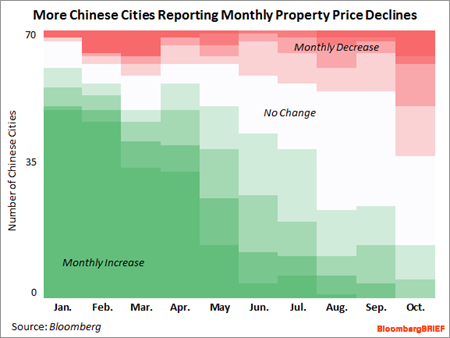People’s Bank of China just cut the reserve requirement ratio by 50 basis points, effectively from 5 December 2011. The last time when the RRR was changed was 14 June, which was a hike of RRR by 50 basis points. RRR for large banks are currently standing at 21.5%, so the 50 basis points cut would reduce the RRR to 21%.
I do not think that this move is very dramatic in the face of the deterioration of the global macro picture. It has been highlighted here earlier that foreign exchange reserve fell in September, and there are evidence that hot money is flowing away from the country, tightening monetary conditions. Thus an RRR cut will probably aim at offsetting some of this recent development.
In the mean time, we already know that the Chinese property market is peaking, and the downward momentum has been building up in more and more cities. Michael McDonough of Bloomberg Brief produced this handy chart to show the increasing number of cities reporting falling prices in the official 70-city prices index:
And in Hong Kong yesterday we have evidence of the ongoing tight monetary conditions with the Authority publishing the latest set of monetary statistics for October 2011.
Hong Kong dollar M1 money supply is falling very slightly on the month (almost unchanged). On a seasonally adjusted basis, M1 fell by 3.1% in October compared to the previous month, and 0.7% compared to October 2010. However, on an year-on-year non-seasonally adjusted basis, it fell by 9.8%. Hong Kong dollar M2 increased by 2.4% in October compared to the previous month, but decreased by 3.7% compared to October 2010. Hong Kong dollar M3 increased by 2.3% compared to the previous month, and decreased by 3.8% compared to October 2010.
Hong Kong dollar deposits increased by 2.5% in October, and total loans increased by 0.6%. This brought the loan-to-deposit ratio down from 86.6% at the end of September to 84.7% at the end of October:
We continue to observe all measures of money supply (M1, M2 and M3) falling in October 2011 on an year-on-year basis just as we saw that in the monetary statistics in September. There are two signs that monetary condition have not gotten much tighter for October, as deposits increased faster than loans, which brought the loan-to-deposit ratio down. Also, on a month-on-month basis, money supply has been stable on most measures.
I expect that deleveraging of European financial institutions would have a negative impact on monetary condition in Hong Kong in the months ahead. That could potentially be offset by monetary easing by central banks, as we have just seen from the People’s Bank of China. At this point, however, with asset prices falling (which by itself could tighten monetary condition), I am not getting too excited.


